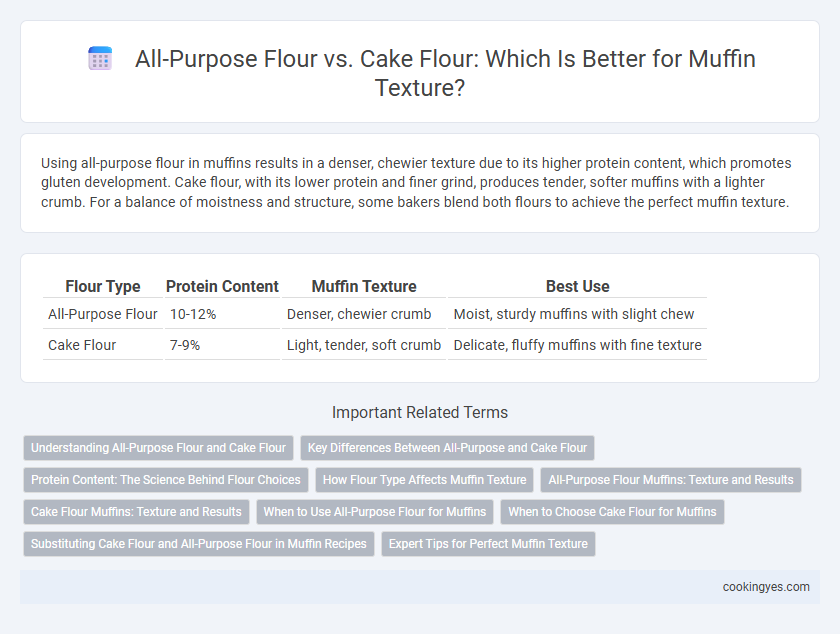Using all-purpose flour in muffins results in a denser, chewier texture due to its higher protein content, which promotes gluten development. Cake flour, with its lower protein and finer grind, produces tender, softer muffins with a lighter crumb. For a balance of moistness and structure, some bakers blend both flours to achieve the perfect muffin texture.
Table of Comparison
| Flour Type | Protein Content | Muffin Texture | Best Use |
|---|---|---|---|
| All-Purpose Flour | 10-12% | Denser, chewier crumb | Moist, sturdy muffins with slight chew |
| Cake Flour | 7-9% | Light, tender, soft crumb | Delicate, fluffy muffins with fine texture |
Understanding All-Purpose Flour and Cake Flour
All-purpose flour contains moderate protein content, typically around 10-12%, which provides structure and a slightly denser texture ideal for hearty muffins. Cake flour has a lower protein content, about 7-9%, resulting in a finer, softer crumb that produces lighter, more tender muffins. Choosing between all-purpose and cake flour directly impacts muffin texture, with all-purpose offering robustness and cake flour enhancing moistness and delicacy.
Key Differences Between All-Purpose and Cake Flour
All-purpose flour contains a moderate protein content (10-12%), providing structure and a denser crumb in muffins, while cake flour has lower protein (7-9%) and finer texture, resulting in lighter, softer muffins. The higher protein content in all-purpose flour develops more gluten when mixed, which can make muffins chewier, whereas cake flour's lower gluten yields a tender, delicate crumb. Choosing cake flour enhances muffin fluffiness and moisture retention, ideal for soft-textured baked goods, whereas all-purpose flour suits denser, more substantial muffins.
Protein Content: The Science Behind Flour Choices
All-purpose flour contains 10-12% protein, providing moderate gluten development that balances structure and tenderness in muffins, while cake flour has a lower protein content of 7-9%, resulting in a finer, softer crumb due to less gluten formation. Choosing cake flour enhances muffin texture by producing a delicate, airy crumb suited for light baked goods, whereas all-purpose flour yields a denser, chewier muffin with more chew. Understanding protein content helps bakers select the optimal flour to achieve the desired balance between muffin structure and softness.
How Flour Type Affects Muffin Texture
All-purpose flour contains moderate protein levels, resulting in muffins with a denser, chewier texture, while cake flour, with its lower protein and finer grind, produces lighter, softer, and more tender muffins. The reduced gluten formation in cake flour minimizes toughness and creates a delicate crumb structure, ideal for moist, fluffy muffins. Choosing between the two flours directly influences the muffin's crumb texture and overall mouthfeel.
All-Purpose Flour Muffins: Texture and Results
All-purpose flour produces muffins with a denser, chewier texture due to its higher protein content compared to cake flour, which results in more gluten development. This gives all-purpose flour muffins a heartier crumb and better structure, making them ideal for flavorful, substantial muffins. The balanced protein level in all-purpose flour provides consistent rise and moisture retention for a moist yet sturdy muffin texture.
Cake Flour Muffins: Texture and Results
Cake flour produces muffins with a tender, delicate crumb due to its lower protein content, which results in less gluten formation. This softer texture enhances moistness and creates a finer, more uniform crumb structure ideal for light, fluffy muffins. Using cake flour instead of all-purpose flour yields muffins that are moist and tender, perfect for recipes emphasizing a soft, melt-in-the-mouth experience.
When to Use All-Purpose Flour for Muffins
All-purpose flour is ideal for muffins when a denser, chewier texture is desired, as it contains more protein than cake flour, which provides greater gluten development. Use all-purpose flour for hearty muffin recipes featuring fruits, nuts, or whole grains, where structure and moisture retention are important. This flour is preferred when a muffin requires a balance between tenderness and robustness, ensuring a satisfying bite without crumbliness.
When to Choose Cake Flour for Muffins
Choose cake flour for muffins when aiming for a tender, soft crumb with a finer texture, as its lower protein content reduces gluten development. This is especially ideal for delicate or lightly mixed muffin batters where a moist, melt-in-the-mouth consistency is desired. Opting for cake flour enhances the muffin's softness and provides a more refined, cake-like quality compared to the denser texture from all-purpose flour.
Substituting Cake Flour and All-Purpose Flour in Muffin Recipes
Substituting cake flour for all-purpose flour in muffin recipes results in a lighter, softer texture due to cake flour's lower protein content, which produces less gluten. When using cake flour as a substitute, increasing its quantity slightly by about 2 tablespoons per cup can help achieve the desired consistency, as cake flour is less dense. Conversely, all-purpose flour can replace cake flour by reducing the amount by 2 tablespoons per cup and sifting it before mixing to maintain tenderness in muffins.
Expert Tips for Perfect Muffin Texture
Using all-purpose flour in muffins provides a denser, chewier texture due to its higher protein content, while cake flour yields a lighter, tender crumb because of its lower protein level. Expert bakers recommend sifting cake flour to incorporate air, enhancing muffin softness and rise. For perfectly textured muffins, combining 50% all-purpose flour with 50% cake flour balances structure and tenderness effectively.
All-purpose flour vs cake flour for muffin texture Infographic

 cookingyes.com
cookingyes.com